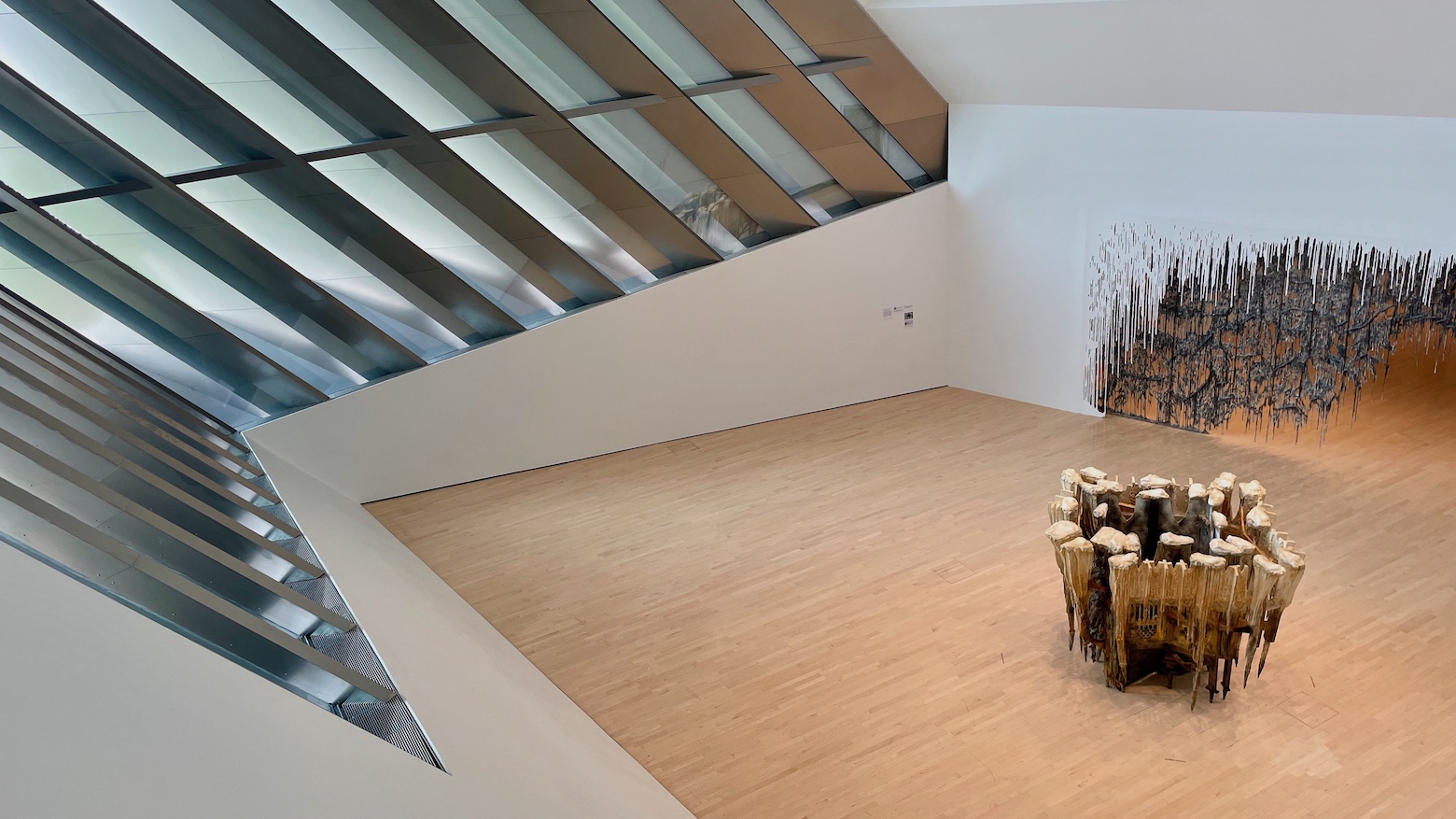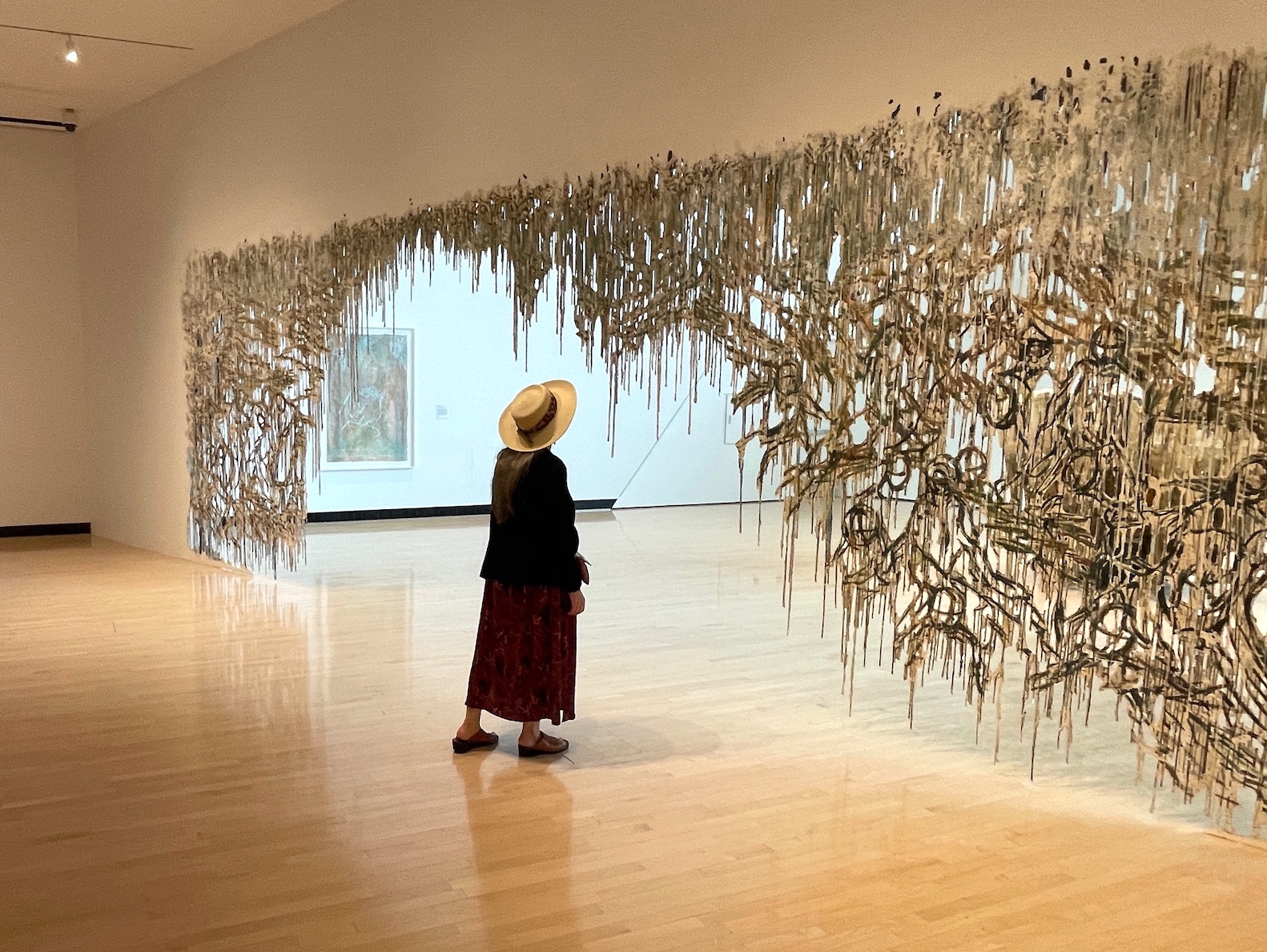
Diana Al-Hadid, unbecoming, Installation view
To be “unbecoming” is to be something of an embarrassment, a disappointment to one’s peers and betters — a failure who couldn’t rise to certain standards and expectations. But if you didn’t sign on to those expectations in the first place, getting tarred as “unbecoming” could be considered a kind of success. To be unbecoming is not the same as to be coming undone. The latter implies dissolution and defeat; the former, with a little linguistic license, can suggest the first steps toward reinvention, a re-becoming.
Sculptor Diana Al-Hadid’s art seems to be in the process of “un-becoming” as well, physically speaking. Her mixed media works are smeary and obscured, cluttered with marks, in low-contrast color schemes that force close observation to discern their subjects. Her paintings appear to have been corroded by some caustic substance, or else by neglect, leaving streaks of muted colors clinging to a lath foundation, but also revealing glints of gold leaf. The works seem fragmentary, perhaps partially lost to time. On the other hand, they could also pass for recently unearthed artifacts, newly discovered evidence that reshapes our thinking about the past and the present.
Much is made in the catalog for unbecoming about Al-Hadid’s use of space, or rather the way she and her work take up space in a world where women are discouraged from doing so. In that sense, it’s appropriate that the exhibition is hosted at the MSU Broad Art Museum in East Lansing, in Zaha Hadid’s jolting stainless steel edifice — a Bowie-esque lightning bolt upon the placid face of the Michigan State University campus. Like the Broad itself, Al-Hadid’s art simultaneously works with and against the environment it occupies: framed prints are suspended in midair by cables rather than hung against walls; a polished bronze disc casts reflections that become part of the artwork; and an arch of made up of Renaissance-inspired figures seems to dissolve and drip down from the top of one gallery entrance, encroaching on the visitor’s space. Then there’s the six-foot model of a Gothic cathedral, inverted so its spires seem to have been driven forcefully into the ground. The placement of the overturned church is such that the diagonals of the room’s windows, like cartoon speed lines, enhance the sense of its catastrophic descent.

Diana Al-Hadid, unbecoming, Installation view Blue Medusa, Mixed Media, 2023
Mythological or art-historical women are often Al-Hadid’s subjects, and her work attempts to complicate or rewrite their stories. The large mixed media wall-hanging Blue Medusa eliminates the face of the gorgon of Greek myth entirely, leaving only a halo of hair — not snakes — writhing around a cut-out void. Minus a face to scrutinize, we’re left wondering what else we got wrong about this “monster.” Three works here are derived from a Northern Renaissance painting called The Allegory of Chastity, in which a woman, hands folded and eyes downcast, is sealed from the waist down inside a gown-like rock face, guarded jealously by two lions. In Deluge of the Allegory Al-Hadid depicts this “protection” of feminine virtue as the prison it is; the mountain is even hemmed in by walls, but from its peak a flood of angry lava flows forth. In the triptych Hindsight, the woman stands flanked by a smoldering volcano and the imposing peak. In Lionless, the woman has banished her feline escorts and stands free and autonomous. (I’ve listed the artworks this way to create a hopeful narrative arc, but Lionless is earlier than the others by seven years, suggesting some rethinking of the subject by Al-Hadid.)

Diana Al-Hadid, unbecoming, Hindsight, Hand-Drawn ballgrain plate, Lithography on Essex paper, 2020

Diana Al-Hadid, unbecoming, August, after The Seventh Month, Polymer gypsum, fiberglass, steel, plaster, metal leaf and pigment. 2025
Motherhood is a subject Al-Hadid visits and revisits here as well. One painting derives from a previous work of hers, from 2015, now at the Toledo Museum of Art. Though obscured and fragmentary as is her style, the Toledo painting appears to be inspired by icons of St. Catherine; a female figure rests one hand on her belly and holds a sword in the other. As the title, The Seventh Month, suggests, Al-Hadid was pregnant with her son when she made the work. In the 2025 follow-up painting, August, after The Seventh Month, Al-Hadid stands just behind her 10-year-old son, and rests a hand on his shoulder. She has passed her protective sword down to him, and if that wasn’t a warning enough, his t-shirt slogan reads “Do Not Disturb.” The world around them is no less in a state of “un-becoming” than before — incomplete, in flux — but together the two seem resolute.

Diana Al-Hadid, unbecoming, Untitled, Bronze, 2014-21 Bronze
The most unusual piece in the show is an untitled disc — more like a puddle — of bronze, looking like a patinated hand mirror that fell, shattered, and then melted in the sun like a forlorn ice cream cone. The polished, fragmented surface casts tangles of reflected light on the wall above it. It was inspired by a sculptural group by Jean-Joseph Perraud representing lyrical drama, part of the facade of the Napoleon III-era Palais Garnier opera house in Paris. In the sculpture, a fallen man is shown his reflection in a mirror by a woman standing to one side, as a winged female figure holding a torch aloft steps over his body. In Al-Hadid’s version, the broken mirror replaces the broken man, and the flickering reflections stand in for the victorious angel, creating a sort of condensed, perhaps lyrical version of the original. (A wall text describing the piece as “a metaphor for deconstructing standards of beauty and conduct” is on-point with the theme of the show, but it’s an unsatisfying explanation of an intriguing piece, especially minus an explanation of the original Perraud piece.)

Diana Al-Hadid, unbecoming, Smoke Screen 2015, Polymer, gypsum, fiberglass, steel, gold leaf, plaster, and pigment

Diana Al-Hadid, unbecoming, Spun of the Limits of my Lonely Waltz Wood, polystyrene, plaster, fiberglass, and pigment, 2006
That drippy veil of fiberglass and gypsum that hangs down across the entrance to the show’s final gallery is entitled Smoke Screen. Amidst the drips are the subtle outlines of multiple figures, inspired by Northern Renaissance artworks, that mingle and intertwine, congregating around the entrance and reaching into the visitor’s space. Beyond the veil is the epically-titled Spun of the Limits of My Lonely Waltz, Al-Hadid’s imposing model cathedral made of plywood, plastic, and plaster. Inverting the structure reveals its foundation (visible from the museum’s second floor), which was formed by the pattern of the artist’s footprints, made as she danced a one-person waltz around her studio. This personal ritual, performed in the sanctity of Al-Hadid’s art-making space, has superseded those of the traditional church, overturning its authority in favor of her own autonomy. The piece is a dramatic exclamation point at the end of an intriguing show.
